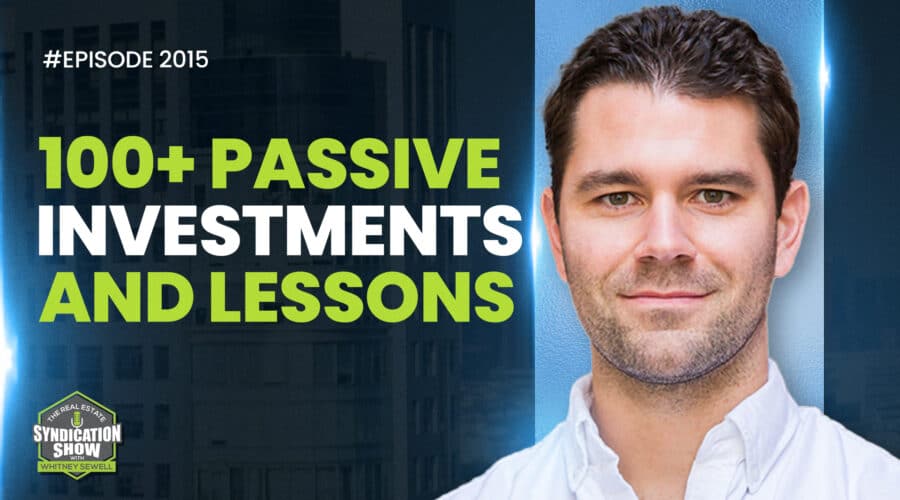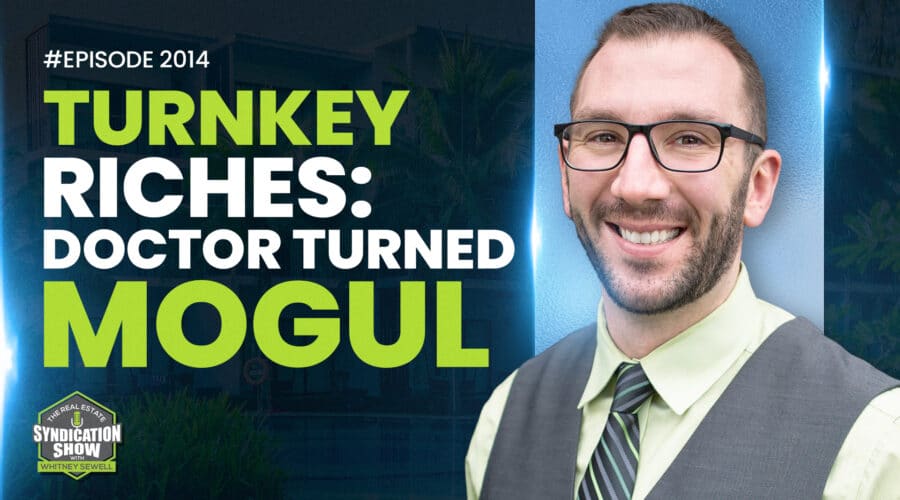In the fast-moving landscape of real estate combined with other factors such as the feds fund rate, interest rates, and the economy, it is difficult for buyers and investors to decide when to buy investment properties. That’s why it is important to have a good grasp of the financing landscape before submitting an offer. More importantly, it is crucial to establish good relationships with lenders and mortgage brokers who will be able to help you navigate a volatile and ever-evolving market.
Our Gracious Sponsor
FIRE Summit 2022
Did you know that multifamily is one of the most recession-resistant strategies to create long-term equity and cash flow, and build wealth through real estate that can save you big on your taxes?
You don’t want to miss Think Multifamily’s annual Fire Summit conference on November 11th & 12th.
Go to thinkmultifamily.com/Fire for more information and to register today!
Enter Promo code: Whitney100 to save $100
Watch the episode here:
Listen to the podcast here:
Our guest today, John Brickson of McKinney Realty Capital, brings us up to date with the current real estate landscape paying close attention to financing and loan options for buyers. He details the factors that affect interest rates and gives his thoughts about better financing options. Listen now and find out why he thinks buying in today’s market is a better opportunity than buying in last year’s environment.
Key Points From This Episode:
- John’s reading of the current debt market conditions and his outlook on federal funds rate, financing and interest rates including non-recourse fixed-rate Fannie Mae and Freddie Mac loans.
- Why bridge loans have become less attractive in financing acquisitions.
- Why John’s company is recommending clients to go into finance and acquisition with a bank loan rather than agency loans that are driven by debt service coverage with lower loan-to-value ratios.
- Why are cap rates not tracking closely with interest rates, what accounts for the gap, and will this trend continue?
- What other factors affect cap rates and interest rates apart from the Federal Reserve’s intervention?
- What strategies can be used to minimize instances where the lender abruptly changes the loan terms to the purchaser’s disadvantage?
- Why it’s better to buy in 2022 versus 2021 and why John advocates people to buy now.
- John’s outlook on the massive bridge debt loans that are maturing in the next two years.
- John’s contact information.
Tweet This!
“In 2021, the financing was great, but the purchase prices were too high or not attractive. And then in 2002, the purchase prices are much more attractive, but the financing is not.”
“I would much rather buy in an environment where the purchase prices are more attractive, and the financing is not as attractive.”
“Why it’s nice to buy in 2022 versus 2021? It’s a buyer’s market. I would advocate people to buy currently because you have some more flexibility on the purchase and sale agreement and the terms of that sale.”
“It’s critical to understand the financing landscape before you go under contract and before your earnest money goes hard.”
Links Mentioned:
About John Brickson
John Brickson is the Founder and Managing Principal of McKinney Realty Capital, a commercial real estate capital advisory firm based in Dallas, TX. Over the past 11 years, John has worked in Commercial Real Estate Finance and Investing as a lender with banks and private equity firms, as well as an intermediary. Since entering the intermediary side of the business in 2019, John has closed over $730MM in financing across over 75 loans. John launched McKinney Realty Capital in 2022 with the goal of building an independent capital advisory firm that offers independent, objective advice for its clients and capital partners. In addition to working full-time as an intermediary, John is actively invested in multifamily and industrial properties as a passive investor and operator. Originally from Kansas City, John graduated from DePauw University in 2011.
Full Transcript
EPISODE 1461
[INTRODUCTION]
John Brickson (JB): In 2021, the financing was great, but the purchase prices were too high or not attractive. And then in 2002, the purchase prices are much more attractive, but the financing is not. And so you delay a loan, but you bury the property. So, the loan is only temporary. And so I would much rather buy in an environment where the purchase prices are more attractive, and the financing is not as attractive. So I’m seeing a lot better values out there in the market for sure. And I’ve seen some prices decline already.
[INTERVIEW]
SR: This is your daily Real Estate Syndication Show. I’m your host, Sam Rust. Joining us today is John Brickson. He’s based out of Dallas, Texas, and is the founder and managing principal of McKinney Realty Capital, a commercial mortgage brokerage that primarily focuses on financing value-add multifamily property. So, right up our alley. In 2022, the firm closed over $300 million across 30 loans so far. In addition to his work on the brokerage side, John invests in multifamily and industrial properties both as a limited principal and a key principal. So John, welcome to the show. Thanks for joining us today.
JB: Thanks, Sam. Glad to be back on the show.
SR: Yeah, definitely. John and I have known each other for a number of years, connected at various conferences and various stories that happen across the space. And we were just talking before the show got going that this is a very interesting time in the financing world. You know, in the five years or so that I’ve been in syndication and multifamily. It seems like equity is the constant focus as part of the overall capital stack and financing. Well, not an afterthought, was certainly something that was relatively stable not so much in 2022. John, I’d be curious for your thoughts on where we sit. You know, we’re at the end of the third quarter here today of 2022. It’s been a ton of volatility, the 10-year treasury has had some pretty significant swings up and down and down and up. And I’d love just your high-level thoughts on where things stand in the debt market today.
JB: Sure. And I’ll say first to start off, it’s September 15, 2022. And things are changing like every week and so this podcast will come out in two or three weeks and so things might be completely different. But where we sit today, 2021 was the year of the floating rate loan, the year of the bridge loan, all of those floating rate loans and bridge loans are priced based on SOFR or CME Term SOFR, which is a short-term, 30-day index, and, you know, 2021 SOFR was close to zero for most of that period of time. And today, SOFR really is tracked closely with federal funds rates. Whenever the Fed increases the target fed funds rate, SOFR will move in lockstep with that. And so, today, SOFR sits at around 2.25%. And the next Fed meeting is September, I want to say it’s 22nd or 23rd, that could be off there. But within the next two weeks, and the span that they’re looking at is inflation. And whereas inflation coming in and Jerome Powell has made it very clear that they’re determined to fight inflation, you know, as much as possible. And my read on that is that they’re going to continue hiking until we start seeing some meaningful declines in inflation.
JB: And so, this last month, just came out that the print came out this week, and it came in at 8.3%. I think some people were, you know, a lot of economists are hoping that would come in, are expected to come in closer to 8%. So it’s a (inaudible), even higher than usual. So my prediction will be that the federal hike 75 basis points on September 23, or whatever that next fed meeting is. Term SOFR will be at 3%. Even been this month. So what does that mean for financing? What does that mean for bridge loans, floating rate versus fixed rate loans? Well, floating rate loans, the rates have increased quite a bit. So the floating rate bonds it’s SOFR plus the spread, and the spread is really the profit for the lender. And so SOFR has increased from zero to 3%. And so there’s been a 3% increase from that and then spreads have increased from the low 300s in 2021, low to mid 300s, and now we’re closer to 400 to 450 over SOFR. And so, really what we’ve seen from the floating rate loans, those interest rates have increased from 3.25%, 3.5%, 3.75% up to today, they’re 7% to 7.5%. And because they’re floating, they could increase when the Fed hikes rates. Then, obviously floating rate loans.
JB: A lot of these lenders will require borrowers to buy what are called SOFR caps which basically is an insurance policy or a hedge that will limit how much SOFR can increase, and then that way mitigate or protect you from potential increases in interest rate during the whole period. And so the cost of that insurance has increased significantly. So what’s really happened is the bridge loans have become less attractive on financing acquisitions. And then the flip side of the fixed rate, and with the fixed-rate loans, those are primarily Fannie Mae and Freddie Mac. You know, unfortunately, there are really not any non-recourse bridge lenders that do fixed-rate loans. So, there’s not really fixed-rate bridge loans out there. You’ll come back to fixed rate for non-Fannie or non-Freddie, but Fannie and Freddie, those loans are really driven by your debt service coverage. So, Fannie and Freddie will go up to 80%. But they require the property can cover the annual principal interest, at least 1.25 times. And because cap rates haven’t moved quite as quickly as interest rates, interest rates have increased the 10-year treasury today is about 3.45%. Sixty days ago, there was about 2.8%, 2.7%. So, I mean, the 10-year treasury yielded about 75 basis points over the last 60 days. And so what that means for Fannie Mae and Freddie Mac loans is that we can only cover at 1.25 times that service coverage on those acquisitions at, you know, 50%, 55%, 60% LTV.
JB: And so Fannie and Freddie are still active, but you just can’t get as high on proceeds as how leverage as you can get with bridge lenders, or with other types of lenders. Now, Fannie and Freddie aren’t the only types of lenders that are doing fixed-rate loans. What we’ve been doing a lot of more recently, I’d say over the last 60 days, and especially in kind of that small bounce space, $10 million and below, $15 million and below, is we’ve been working with a lot of banks and credit unions because banks and credit unions are oftentimes able not all and every bank and credit, every bank and lenders are different. Some are okay doing fixed rates, some will not do fixed rate, some will do fixed rate only for two or three years. We’ve been doing a ton of loans with the local banks, because the local banks, they’re not DSCR-constraint at a 1.25 times that service coverage. And they can do three to five years fixed.
JB: So more recently, especially if it’s $10 million and below, we’ve been attracting our clients to go into finance and acquisition with a bank loan. And a lot of times, you know, they are recourse, but you can get 75% of the cost of 5.25% interest rate fixed, one-year bio, 25 years and thereafter, it is recourse. But you know, a lot of borrowers they look at that, they compare it with the bridge option that we bring to the table, and they might see that the bank loan is it’s fixed, there’s no silver cap requirement, closing costs are much lower. And my interest rate is 200 basis points inside of the bridge lender. So, they’re willing to make that trade-off to sign. But I guess I’ll wrap all this up, by saying, Sam, that in 2021, let it slide a lot of borrowers this. In 2021, the financing was great, but the purchase prices were too high or not attractive. And then in 2002, the purchase prices are much more attractive, but the financing is not. And so you, delay a loan, but you bury the property. So the loan is only temporary. And so, I would much rather buy in an environment where the purchase prices are more attractive, and the financing is not as attractive. So I’m seeing a lot better values out there in the market for sure. And I’ve seen some price decline already.
SR: We’ve certainly seen that across our markets as well that the ask is coming down to what I would call more realistic levels. But even so it does seem like there’s a big spread between the bid and the ask on properties that are for sale. You mentioned that cap rates aren’t tracking as closely with interest rates. Do you anticipate that to continue? And why is there a gap? Why are cap rates slower to respond in your opinion?
JB: So yeah, I think a lot of that really comes down to how motivated is the seller? Are they ready to sell? Are they are they willing to sit out for another year? Two years, three years or however long it takes for the market to recover? So I’ve seen certain situations where people take their property out to market and the listing broker gave them broker opinion of value at a certain price and the offers come in and you know, they’re the offers are 10%, 15% below the asking price and you know, that seller, they might have a long term fixed rate loan and they’re getting credit growth. They might just say a lot of certain way, just continue to cash flow the property.
JB: I’ve seen other cases where there’s people who they might have bought the property two or three years ago and you know, they financed the acquisition with a loan that has a lower prepayment penalty whether it was a bridge loan or as a bank loan or as an agency loan and stepped down prepay and they get an offer that comes in a lot of times especially if you’re a syndicator. They can say okay for my investors and you know, doing kind of the best I can for my investors I can take this offer today. And you know maybe the brokers opinion the value if I’ve got that price would be a grand slam. But I’ll take this off today and in the grand slam I get it. And it’s still a really solid return for my investors. And I can wait four more months, and maybe the broker will recover. But my loan might be mature in 12 months, or I have less term of my loan. And you know, maybe pricing isn’t as strong, maybe the market continues to decline. And so a lot of those owners are willing to accept our prices.
JB: And I have some cases where like, it’s a long-term family ownership, they’ve had that property for 20 years, and they’re still seen as pricing is, you know, being a great return over the term. They’ve already had multiples return on their initial investment, because they’ve had it so long and so that’s really the logical sell. I’ve seen properties that like, I’m working on a three-property portfolio right now that’s in DFW. And I mean, it went under contract at $47 million, right, as rates started increasing. And then it fell out of contract. And I’m up for the buyer that’s going under contract for $34 million. So it’s like 25%-plus reduction. I’m seeing another property DFW that’s in north Dallas that was under contract at $43-$44 million, and as part of our contract at I think, $35 and a half, but somewhere in that range.
JB: And so it just comes down to how motivated the sellers are. And then to answer your question about will this continue – the bid and ask spread? You know, I think as we get, you know, longer in kind of this down cycle, and, you know, hopefully doesn’t last too long. But, you know, I think as interest rates start increasing, and frankly, like a lot of people finance their acquisitions with floating rate bridge loans in 2021. And if floating rates keep increasing, and people get in situations where, you know, maybe their cash flow is just above a 1.0 coverage, or they’re not generating enough cash flow, to pay their principal and interest, or they’re a syndicator. And they’ll have to call capital, or whatever, you know, whatever it may be, I think they’ll be more motivated sellers. And that just for motivated sellers, you’ll start to see that bid-ask spread come down and start to see cap rates are really starting to increase.
SR: When you look out to the future projection is always kind of a fool’s errand. But is it really as simple as saying, cap rates, interest rates are generally going to rise until the Feds starts cutting in response to a recession that they’ve probably caused? Or are there other factors that you’re watching?
JB: You know, I think there’s always a relationship between cap rates and interest rates. I mean, there’s not a perfect correlation there. But I think there’ll be some increase in cap rates. I think there just has to be, you know, if interest rates continue to increase, and if they do stay high, and, you know, once the Fed does cut, that will get to a point where interest rates are, you know, very low and cap rates are still high. And you finance acquisitions with Fannie Mae loans at 80% LTV again, but I also think, you know, there’s some other variables in multifamily that I think are going to make, you know, I think, a lot of the other property types, like office properties, you know, especially, you know, hotels, retail property has already gone through credit, secular decline. I think retail has been recovering, but there’s so much more capital allocation toward multifamily. There are so many positive factors for multifamily that I think we’ll continue to see lower cap rates for multifamily (inaudible) or property types, but I do think we will see some increase in cap rates, you know, especially if the 10-year treasury stays at three and a half percent. I see cap rates increasing.
SR: You mentioned several properties that have fallen out of contract. We’ve seen that as well. We’ve also seen some fallout because the lender decided to change the terms at the last second. How can you minimize that risk, if you’re on the purchaser’s end, where you’re trying to get to the finish line with a lender, you do want to seal your vows, without the terms changing drastically, what strategies are you seeing folks employ these days to try to minimize that?
JB: So again, another reason why it’s nice to buy in 2022 versus 2021, I would advocate people to think about buying currently, is that it’s a buyer’s market, and once a buyer’s market, you might have some more flexibility on the purchase and sale agreement, the terms of that sale. So you know in 2021, you had to put up a significant amount of non-refundable earnest money day one and in some markets and maybe see that in DFW, a lot of borrowers aren’t having to put up earnest money until two weeks in or 30 days into their contract. And so, I would say is like, number one, if you can start looking into your financing and understanding what the financing landscape is before you even go under contract and then even better to have some more runway, you know, before your earnest money goes hard. It is critical for you to understand your financing, understand the outlook for financing very, very early in the process. I mean, ideally, you’re talking to your lenders or your mortgage broker before you submit your best and final offer, and reviewing the pro forma business plan with them just understanding like, what the terms are out there. And then as soon as you have an accepted LOI, you or your mortgage broker are going out actually getting loan applications from lenders, and hopefully you have multiple options. And then you know, you’re that’s far as long as possible in the first two weeks versus three weeks or whatever it is, before your money goes hard. And in that way, you could avoid that situation where there’s a retrade when the lender does fall out, because it is happening, you know, you’re at least prepared to avoid it.
JB: You know, where people get into trouble is if they put the loan on the backburner, and they don’t spend any time on the loan, and then two weeks after the PSA, they start shopping the financing. And then, you know, they come to realize our pro forma, you know, these friends aren’t supported by the market or whatever they end up finding one outlier lender who says they’ll do the loan, and nobody else will, and also that outlier lender is like oh actually kicked the slap, or we’re at 65% instead of 80% LTV or whatever it may be. So I’d say that’s one thing.
JB: I’ll just give an interesting story about like a loan, where we got the phone quote, retraded but actually kept the borrower and said, every trade that I’m telling you right now, so I had a loan where it was a two-property portfolio in DFW. We’re doing a $25 or $26 million loan and we put our package together. We showed it to probably 25 different lenders, and most of the lenders came back at, you know, kind of 70% LTV, low 70s. And we had one that came back at 75% LTV, and we have this group of 75% LTV, their interest rate that seems competitive, and it seems like a market rate. It’s not like an outlier, really. And they said, well, we really want an 80%. So I said okay, you can go back and see if we get 80%. So I was wondering, I said, you know, can we get 80%? They said well, I think we could stretch just below 80%. And said, okay, let’s just get a loan out here at just below 80%. And so I do have one application and gone to call the borrower and I said loan amount says 80% or close to 80%. But I’m telling you, be ready to close at 75%. Because this is the debt yield, this is the DSCR. I said, here’s all the different areas where you know, they could potentially get us because I’m looking at our underwriting. I’m looking at their steps, and I don’t see us meeting these steps. And so just be ready to close at 75%.
JB: But sure enough, we got it now two weeks out from closing, the letter comes back. They didn’t cut our proceeds. They offered us three different options that can maintain proceeds where they were, but increase our spread from 400 over SOFR to 435 over SOFR, that was option one. Option two, something in between, a slight reduction in proceeds, but a slight increase in spread and option three was 75%, at 400 over SOFR. So we kind of knew going in that there’s a risk here that this could get retraded and then just you know, having enough repetitions and enough going through this multiple times with lenders, I kind of cut the borrower, a borrower for it, and it ended up working out okay, so I think, you know, to me, a retrade, or that retrade is just when they’re completely blindsided and you just don’t even see it coming. I think, not to plug myself here but I think working with a good broker, especially in today’s market where things are very volatile, and things are changing constantly, working with someone that does, you know, 30, 40 of these loans per year can be very helpful.
SR: I appreciate that, that color is helpful. I was looking the other day at some loan maturity dates across the multifamily industry. And you’re right, there’s a big wall of loans maturing in 2023, 2024. A lot of bridge debt that’s coming due at that point in time, you know, at least the initial three-year term. Over the last 10, 12 years, I think people were really aggressive with bridge debt. And they got bailed out by rising tide in many different ways compressed cap rates, increased rents. You know, we’re still seeing increases in rents, although I think that’s going to slow down somewhat, but cap rates are increasing. You know, we went through some price reductions that we’re seeing anecdotally in various markets. Do you think that the market will bail out folks who let’s say they’re maturing in the back half of 2023 into 2024? Or do you think there might be some real pain that could lead to a little bit of a domino effect?
JB: Yeah, and I think now more than ever, operations are really important. And I think the better operators will do just fine. And the people that can execute their business plan and the borrowers are well capitalized to kind of get through, you know, some of these issues with increasing rates, I think we’ll do just fine. But I do think this will be a period for people who are not as strong at operations, markets that aren’t as attractive. Markets for multifamily I think will end up having issues and, you know, will it be 2008? Will it be, you know, total on the streets? I don’t think it will be, but I do think there will be, you know, some properties that have issues, there will be some borrowers that end up losing money, and I think there will be some distress in the next few years.
SR: Interesting to think of all the distressed capital funds that were raised right around COVID. And very little of that capital ended up being placed, maybe they were just 30 to 40 months early.
JB: Yeah, I mean, I haven’t heard of any distress or any pockets that are having issues quite yet. But as I mentioned earlier, I think as we get longer into the down cycle, further in between 2023 and if rates stay where they are, I think we’ll see some issues. But you know, to your point, there have been so many funds that have been raised to kind of capitalize on these opportunities, and there’s a lot of people who are waiting on the sidelines to pass. I don’t know if there’ll be a very big window to jump ahead. And I think a lot of people, you know, for sure it’s going to get the multifamily, the fundamentals are still really strong. So we’ll see how it plays out.
JB: I don’t see it being a, you know, very large downturn, but I think it’s to your point a lot got bailed out on the market prices, the market improving. I think people also got bailed out by the fact that they have fixed-rate agency loan, like a lot of properties from 2015 to 2018 were financed with Fannie Mae or Freddie Mac fixed-rate loans and the operators that have issues but bond rates are performing well, they had a fixed-rate loan with a 10-year term. So they had 10 years to figure it out. Whereas everyone that bought in 2021, they bought with bridge loans and bridge loans, you know, you’d have two to three years to get your operations and business plan and, you know, a few that you haven’t executed by end of year two, end of year three, you’re in a situation where your loans maturing, and the property’s worth, you know, less than (unintelligible) potentially you’re underwater, so I think that’s gonna play a big factor, That’s for sure.
SR: Awesome. Well, if folks want to reach out to you, learn more about what you do at McKinney Capital Realty. Can you share where folks can reach out?
JB: Our website is McKinneyRC, so it’s M-C-K-I-N-N-E-Y-R-C dot com (www.McKinneyRC.com) . And you’ll find my contact information and also my colleague Henry Holt, his contact information is on there as well.
SR: Fantastic. Well, John, really appreciate you joining us today on the show. Thanks for sharing your insights. And thank you to our audience for joining us. This is your host Sam Rust, signing off.
[END OF INTERVIEW]
[OUTRO]
WS: Thank you for being a loyal listener of the Real Estate Syndication Show. Please subscribe and like the show. Share it with your friends so we can help them as well. Don’t forget, go to LifeBridgeCapital.com where you can sign up and start investing in real estate today. Have a blessed day.
[END]
Love the show? Subscribe, rate, review, and share!
Join the Real Estate Syndication Show Community:






